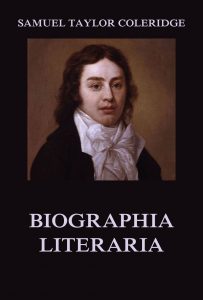Biographia Literaria – Samuel Taylor Coleridge
Coleridge, with his superior philosophical training and profundity of thought, became one of England’s greatest critics, despite his digressiveness and verbosity. The Biographia Literaria (1817), a collection of his literary life and opininions, is both autobiographical and critical. Intended as a mere preface to a collected volume of his poems, explaining and justifying his own style and practice in poetry, the work grew under his hands to a literary autobiography, including, together with many facts concerning his education and studies and his early literary adventures, an extended criticism of Wordsworth’s theory of poetry as given in the preface to the ‘Lyrical Ballads’ and a statement of Coleridge’s philosophical views.
Format: Paperback.
Biographia Literaria.
ISBN: 9783849673451.
Available at amazon.com and other venues.
About the Biographia Literaria (from wikipedia)
In addition to his poetry, Coleridge also wrote influential pieces of literary criticism including Biographia Literaria, a collection of his thoughts and opinions on literature which he published in 1817. The work delivered both biographical explanations of the author’s life as well as his impressions on literature. The collection also contained an analysis of a broad range of philosophical principles of literature ranging from Aristotle to Immanuel Kant and Schelling and applied them to the poetry of peers such as William Wordsworth. Coleridge’s explanation of metaphysical principles were popular topics of discourse in academic communities throughout the 19th and 20th centuries, and T.S. Eliot stated that he believed that Coleridge was “perhaps the greatest of English critics, and in a sense the last.” Eliot suggests that Coleridge displayed “natural abilities” far greater than his contemporaries, dissecting literature and applying philosophical principles of metaphysics in a way that brought the subject of his criticisms away from the text and into a world of logical analysis that mixed logical analysis and emotion. However, Eliot also criticises Coleridge for allowing his emotion to play a role in the metaphysical process, believing that critics should not have emotions that are not provoked by the work being studied. Hugh Kenner in Historical Fictions, discusses Norman Fruman’s Coleridge, the Damaged Archangel and suggests that the term “criticism” is too often applied to Biographia Literaria, which both he and Fruman describe as having failed to explain or help the reader understand works of art. To Kenner, Coleridge’s attempt to discuss complex philosophical concepts without describing the rational process behind them displays a lack of critical thinking that makes the volume more of a biography than a work of criticism.
In Biographia Literaria and his poetry, symbols are not merely “objective correlatives” to Coleridge, but instruments for making the universe and personal experience intelligible and spiritually covalent. To Coleridge, the “cinque spotted spider,” making its way upstream “by fits and starts,” [Biographia Literaria] is not merely a comment on the intermittent nature of creativity, imagination, or spiritual progress, but the journey and destination of his life. The spider’s five legs represent the central problem that Coleridge lived to resolve, the conflict between Aristotelian logic and Christian philosophy. Two legs of the spider represent the “me-not me” of thesis and antithesis, the idea that a thing cannot be itself and its opposite simultaneously, the basis of the clockwork Newtonian world view that Coleridge rejected. The remaining three legs—exothesis, mesothesis and synthesis or the Holy trinity—represent the idea that things can diverge without being contradictory. Taken together, the five legs—with synthesis in the center, form the Holy Cross of Ramist logic. The cinque-spotted spider is Coleridge’s emblem of holism, the quest and substance of Coleridge’s thought and spiritual life.
(The text of the last section was taken from a Wikipedia entry and is available under the the Creative Commons Attribution-ShareAlike License.)
Publisher’s Note: This book is printed and distributed by Createspace a DBA of On-Demand Publishing LLC and is typically not available anywhere else than in stores owned and operated by Amazon or Createspace.

